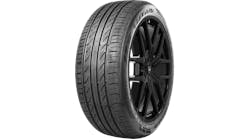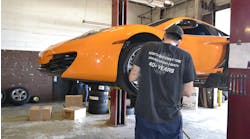Unlike Monaco, Canada is not entirely a street circuit because as well as the normal streets on the man-made island in the St Lawrence river, there is also section of permanent track that is open only for the purpose of racing. The total lap length is 4.361 kilometers (2.710 miles), repeated 70 times for the grand prix, on a circuit that consists of extremely smooth asphalt offering variable levels of grip.
There are six major braking points (making the track the most demanding of the year on brakes) combined with three chicanes and four high-speed corners.
The tight section in the middle of the track is characterized by two chicanes, a double braking area, and some rapid changes in direction – all in the space of less than 700 meters. These extreme stresses raise the tread temperature of the tires by 20 degrees Celsius (68 degrees Fahrenheit) in just 15 seconds, with a peak temperature exceeding 110° degrees Celsius (230 degrees Fahrenheit).
One of the most demanding areas of the entire lap for the car, driver and tires is the long hairpin bend where the cars scrub off 230 kph (143 mph) during the approach – down from 290 kph (180 mph) to just 60 kph (37 mph) – in less than three seconds over the space of only 130 meters. These parameters combine to produce a vertical pressure of 1100 kilograms (2420 pounds) on the front tires. Entering this corner is one of the prime spots for overtaking.
The Montreal circuit is also known for its variations in surface and nowhere is this more evident than in the pitlane. The track surface there consists of one section of asphalt and one of concrete, each of which provide a different coefficient of friction, which naturally affects the amount of rubber laid down and grip. The adaptability of the P Zero compounds is designed to ensure a consistent performance over a wide variety of surfaces.
The Strategy
Getting the race strategy right has become more important than ever with the latest generation of Formula One tires. While the strategy depends on a number of different factors, the most important question for teams to decide is during which point of the race they wish to be fastest.
Opting for the quickest tire – which usually corresponds to the softest available compound – at the start of the race will enable drivers to make a quick getaway and pull out an early advantage: but this may come at the price of being overtaken by drivers who are on the quicker tire during the middle and final stints of a race.
Conversely, drivers who start on the harder tire may be able to jump (or ‘undercut’) their rivals at the first pit stops in order to gain track position, but they will come under a lot of pressure during the early phases of the race due to their rivals making the most of the faster tires.
At the first round of pit stops, there is another crucial decision to be made: should the driver move onto a different type of tire to the one on which he started or duplicate his original choice? Going onto a different choice creates more flexibility in the strategy, as the rules state that you have to use each nomination at least once. If, by contrast, you duplicate the choice with which you started then you have to make one more stop.
Teams use complex computer programs to simulate their race speeds using different strategies, but one thing that these systems cannot take into account is the strategies that other people are adopting and the likelihood of being blocked, either by slower competitors, the nature of the circuit, or racing incidents such as accidents and safety cars.
Teams study the likelihood of such occurrences carefully (Canada, for example, has a 67% probability of a safety car appearance) and these have a major influence on the strategy. The weather is also a big factor, as the arrival of rain often sends most strategies out of the window.
How easy the track is to overtake on forms an integral part of the strategy, and unlike Monaco, Canada presents a number of passing opportunities, which means that the teams can afford to use a more adventurous strategy if it suits them, as opposed to Monaco, where the lack of passing places tends to lead to more conservative strategies.
Ultimately, the key ingredient to every strategy is flexibility. The teams with the most reactive tacticians often score the top results, as they are able to respond in real time to unforeseen events and the initiatives from their rivals. With Pirelli’s new range of P Zero tires providing another exciting but changeable element to the races this year, speed of reaction is more vital than ever.


